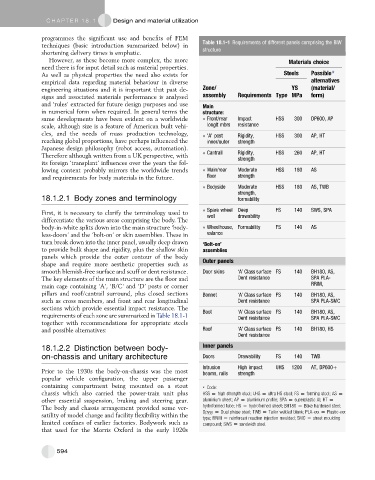Page 583 - Automotive Engineering Powertrain Chassis System and Vehicle Body
P. 583
CHAP TER 1 8. 1 Design and material utilization
programmes the significant use and benefits of FEM
Table 18.1-1 Requirements of different panels comprising the BIW
techniques (basic introduction summarized below) in
structure
shortening delivery times is emphatic.
However, as these become more complex, the more Materials choice
need there is for input detail such as material properties.
As well as physical properties the need also exists for Steels Possible*
empirical data regarding material behaviour in diverse alternatives
engineering situations and it is important that past de- Zone/ YS (material/
signs and associated materials performance is analysed assembly Requirements Type MPa form)
and ‘rules’ extracted for future design purposes and use Main
in numerical form when required. In general terms the structure:
same developments have been evident on a worldwide Front/rear Impact HSS 300 DP600, AP
scale, although size is a feature of American built vehi- longit mbrs resistance
cles, and the needs of mass production technology, ‘A’ post Rigidity, HSS 300 AP, HT
reaching global proportions, have perhaps influenced the inner/outer strength
Japanese design philosophy (robot access, automation).
Therefore although written from a UK perspective, with Cantrail Rigidity, HSS 260 AP, HT
strength
its foreign ‘transplant’ influences over the years the fol-
lowing content probably mirrors the worldwide trends Main/rear Moderate HSS 180 AS
and requirements for body materials in the future. floor strength
Bodyside Moderate HSS 180 AS, TWB
strength,
18.1.2.1 Body zones and terminology formability
First, it is necessary to clarify the terminology used to Spare wheel Deep FS 140 SWS, SPA
well
drawability
differentiate the various areas comprising the body. The
body-in-white splits down into the main structure ‘body- Wheelhouse, Formability FS 140 AS
less-doors’ and the ‘bolt-on’ or skin assemblies. These in valance
turn break down into the inner panel, usually deep drawn ‘Bolt-on’
to provide bulk shape and rigidity, plus the shallow skin assemblies
panels which provide the outer contour of the body
shape and require more aesthetic properties such as Outer panels
smooth blemish-free surface and scuff or dent resistance. Door skins ‘A’ Class surface FS 140 BH180, AS,
The key elements of the main structure are the floor and Dent resistance SPA PLA-
main cage containing ‘A’, ‘B/C’ and ‘D’ posts or corner RRIM,
pillars and roof/cantrail surround, plus closed sections Bonnet ‘A’ Class surface FS 140 BH180, AS,
such as cross members, and front and rear longitudinal Dent resistance SPA PLA-SMC
sections which provide essential impact resistance. The
Boot ‘A’ Class surface FS 140 BH180, AS,
requirements of each zone are summarized in Table 18.1-1
Dent resistance SPA PLA-SMC
together with recommendations for appropriate steels
and possible alternatives: Roof ‘A’ Class surface FS 140 BH180, HS
Dent resistance
18.1.2.2 Distinction between body- Inner panels
on-chassis and unitary architecture Doors Drawability FS 140 TWB
Intrusion High impact UHS 1200 AT, DP600þ
Prior to the 1930s the body-on-chassis was the most beams, rails strength
popular vehicle configuration, the upper passenger
containing compartment being mounted on a stout * Code:
chassis which also carried the power-train unit plus HSS [ high strength steel; UHS [ ultra HS steel; FS [ forming steel; AS [
other essential suspension, braking and steering gear. aluminium sheet; AP [ aluminium profile; SPA [ superplastic Al; HT [
The body and chassis arrangement provided some ver- hydroformed tube; HS [ hydroformed sheet; BH180 [ Bake hardened steel;
satility of model change and facility flexibility within the Dpyyy [ Dual phase steel; TWB [ Tailor welded blank; PLA-xxx [ Plastic-xxx
type; RRIM [ reinforced reaction injection moulded; SMC [ sheet moulding
limited confines of earlier factories. Bodywork such as compound; SWS [ sandwich steel.
that used for the Morris Oxford in the early 1920s
594

